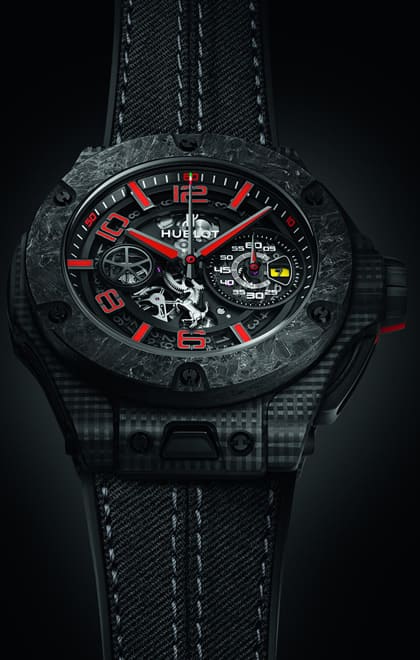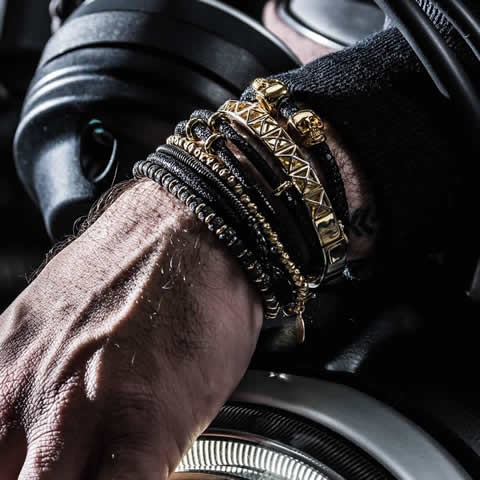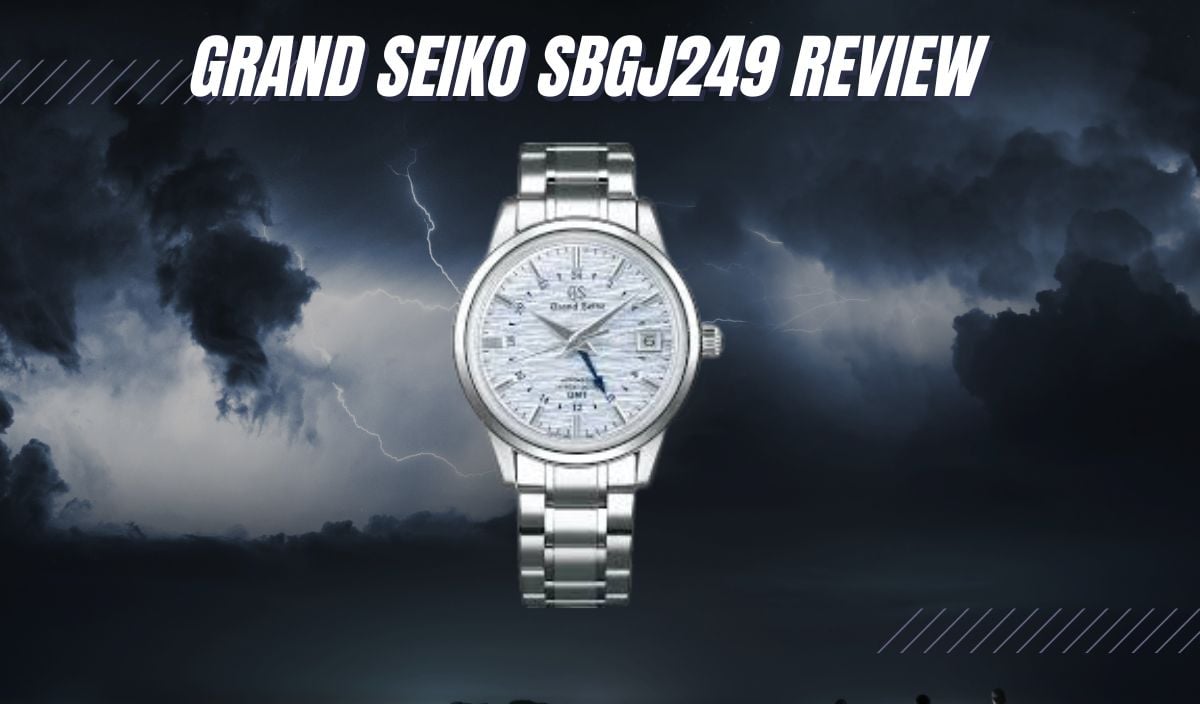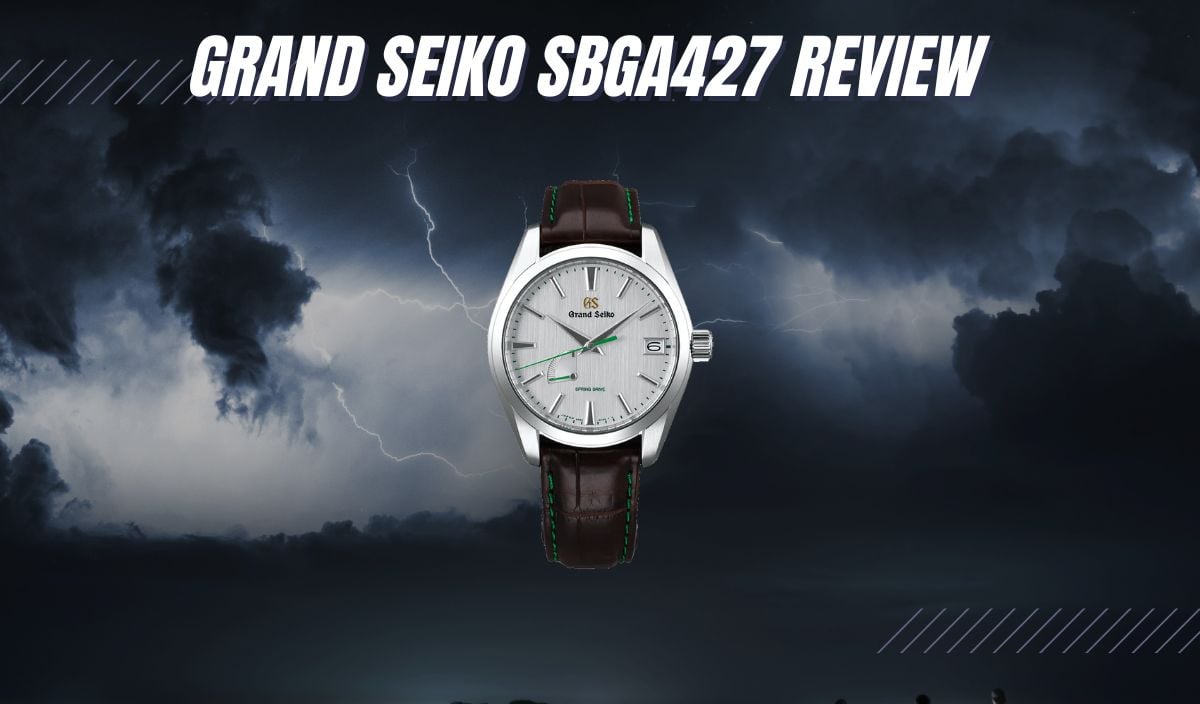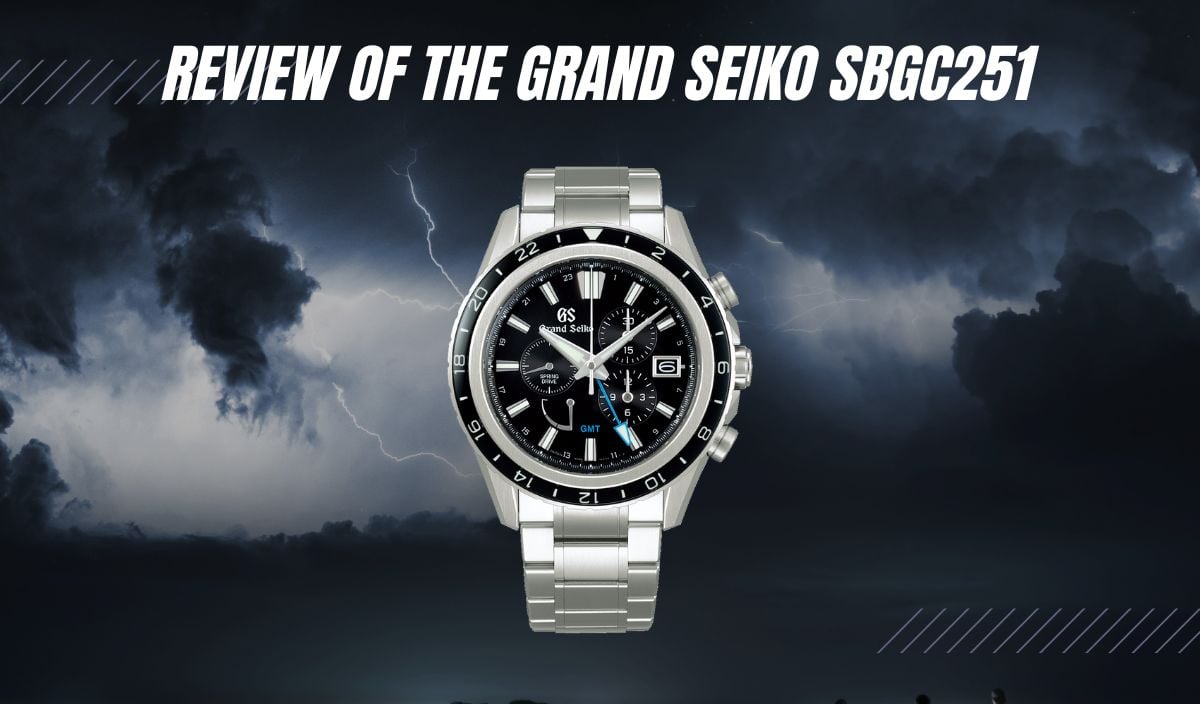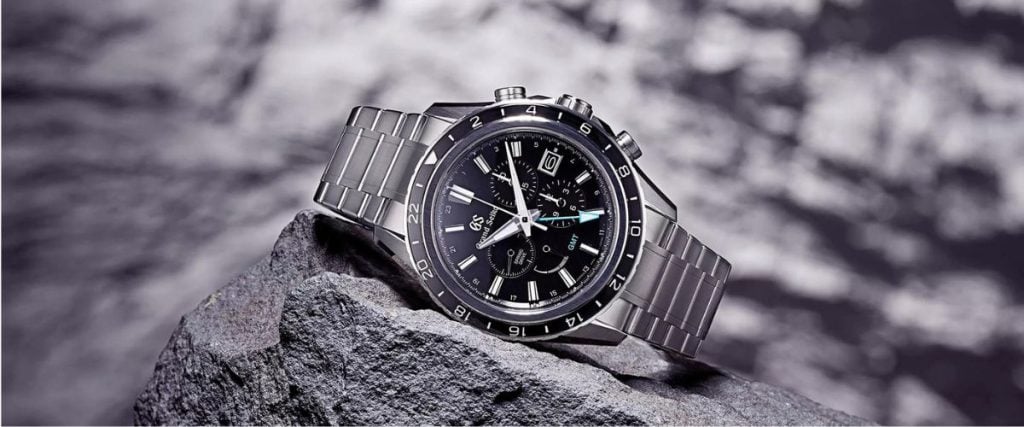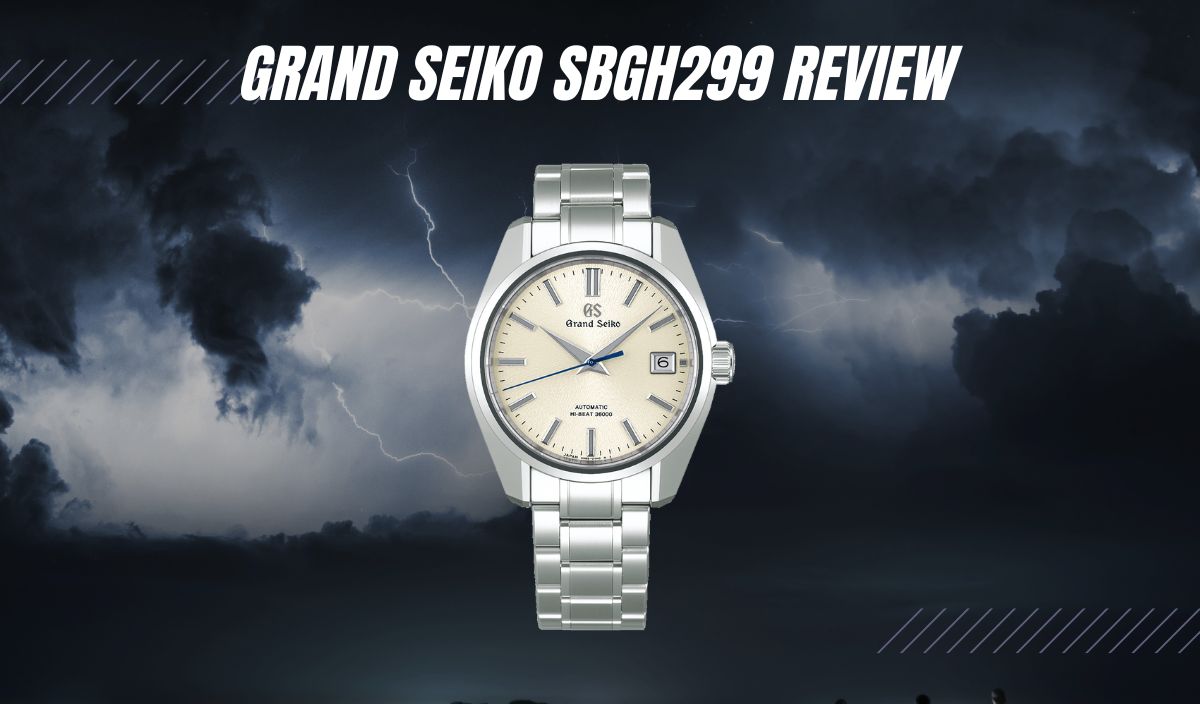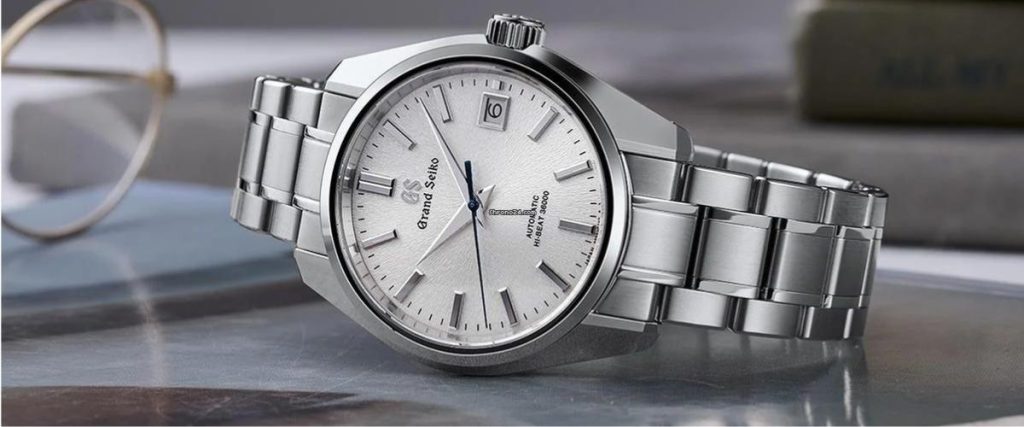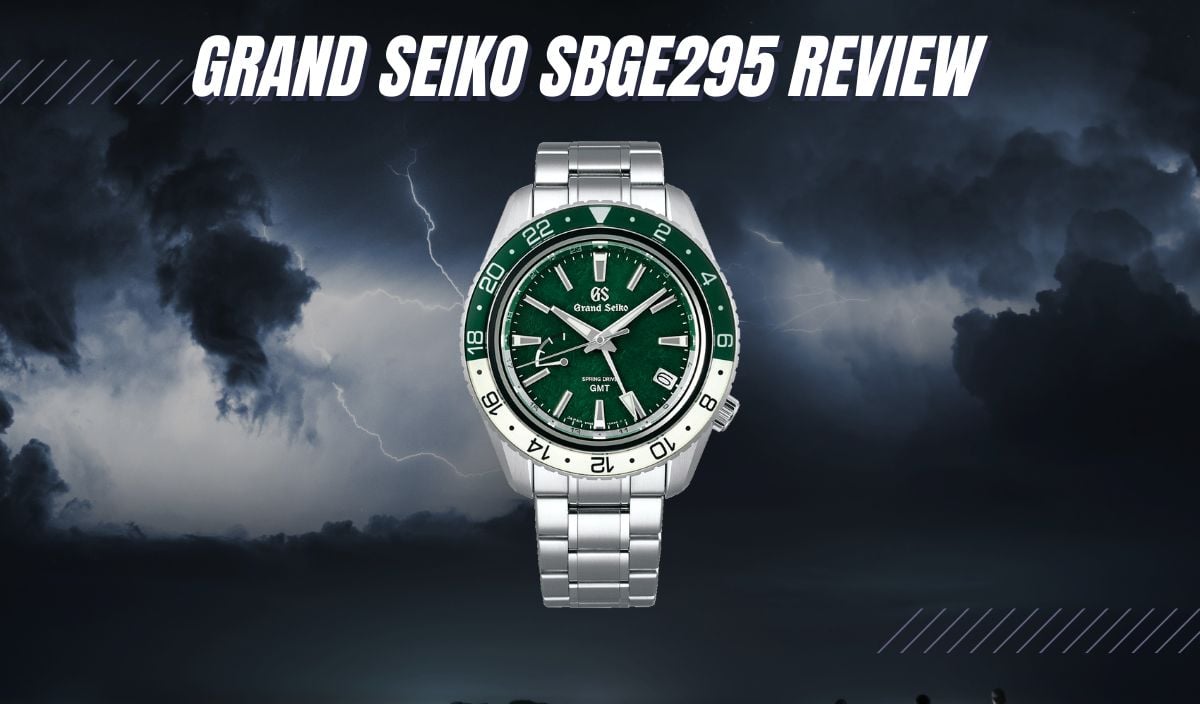
Part of what makes Grand Seiko such a timeless investment is the craftsmanship and historical quality that goes into it. As you might expect, those details can get pretty extensive, but they all matter when it comes to the visual symphony of the final product.
The watch brand has a core focus on ease of use without skipping on the beauty and precision of its mechanical components. Aside from their many collections, Grand Seiko has always had a knack for taking inspiration from nature for its designs.
You can definitely see this in the SBGE295, as the design of the dial is inspired by the peaks of the Hotaka Mountains in Japan. This watch’s natural green tone draws me in the most, and it’s clear that many others agree. In this review, I’ll show you all of the highlights from the SBGE295 and give you a great visual of how it would stand out in your collection.
A Glimpse at the History of SBGE295

Manufactured in two unique locations throughout Japan, each Grand Seiko watch is born in the Shizukuishi or Shinshu watch studios. This particular watch was made available in July of 2023, and it is one of the newer designs from Grand Seiko in recent years.
The SBGE295 is an addition to Grand Seiko’s Sports Collection, which is known for its blend of style and sporty lifestyle. A personal favorite when it comes to more relaxed engagements.
Although it isn’t uncommon for Grand Seiko to reissue or take inspiration from older models, this particular design stands as a fresh perspective. You can find similar designs within their Sports Collection, but these are known to be rather new to the Grand Seiko lineage. There may not be an extremely long history behind this design, but it still stands as a new favorite in my own collection.
It’s a great example of how the watchmaker has come so far and the level of effort and detail they put into every creation. Even after decades on the global market, that historical quality is still found in the details of every timepiece, including the “Hotaka Peaks” SBGE295. This watch sits among a few others in its collection, but it’s the green contrast that really makes it special.
Case Specifications Unwravelled
At a glance, a 44mm case diameter sounds somewhat large to anyone, but Grand Seiko put some thought into that for a better feel. This was accomplished by engineering a curved case while still displaying the visual aesthetic of a 44mm diameter.
Take it from someone with a noticeable skinny wrist; I feel this watch looks and fits just fine from every angle. A small detail like this can make a watch much more comfortable on the wrist for all-day wear.
Aside from the case diameter, the watch is 50.8mm lug-to-lug and has a thickness side profile of 14.7mm. Once again, the lug-to-lug can look on the larger side, but this is compensated by GS’s clever approach with a curved case.
It works with a Spring Drive movement and boasts a stainless steel housing with durable sapphire crystal. These small design choices make the watch stylish, durable, as well as scratch resistant.
While you might feel like the case dimensions would be bulky, my own experience has been pleasantly form-fitting. My relatively small wrist has made it challenging to blend with some watch styles, but Grand Seiko Engineering always finds a way to make it work.
This particular watch case boasts the Zaratsu finish, popularized by the Grand Seiko name. Better yet, you’ll find a majority polished look, with some light brushing on the lugs. Down to the finer details of the case, the bezel is bi-directional, offers a soft click, and comes with a sapphire insert.
White portions of the bezel glow in the dark due to the fine layer of Grand Seiko’s LumiBrite compound. It’s also made with a screw-down crown placed at 4 o’clock and locks in at a water resistance of 200m.
Even if you don’t see the case back very often, it comes with the famous engraving that makes it an official Grand Seiko. Also made from stainless steel, the case back shows the famous Grand Seiko lion engraved in the middle.
Part of what sells me about this watch case is the fact it hits the perfect middle ground between sport and luxury style. Although case design can be a big selling point for many people, the dial offers plenty of hidden beauty and engineering.
Details of the Dial
The dial is a standout feature, to say the least, as it includes a vibrant, patterned green color. It represents the lush nature of the Hotaka Mountains, and the overall finish is unique to its own as well. On top of the fully LumiBrited bezel, the same approach is taken on the hands. This ensures perfect visibility in the dark without being too jarring to the eyes.
Amongst the deep greens in this dial are also very faint blue undertones in the right lighting. The deep color of the dial and the form-fitting nature of the watch make it perfect for on-the-go or more professional settings.
Grand Seiko created this specific dial pattern in hopes of honoring the sharp winds that have shaped the Hotaka Mountains over time. At a glance, the pattern seems somewhat random, but this doesn’t deflect from its beauty in the slightest.
Its surroundings are complemented well by the 24-hour crystal bezel, the contrast of white and silver tones, in addition to day and night indicators. Throughout the watch brand’s history, they have played with many hues of green in their timepieces. This shade is specifically one of the boldest, in my opinion, and the textured pattern only takes it to new heights.
You’ll find a small date window at the 4 o’clock position that’s easy enough to read but not large enough to distract from the dial’s beauty. Other details include the power reserve indicator at the 9 o’clock position, and indices are engraved with a visibly ribbed texture. I love that the minute track is equally vibrant to its surroundings without taking away from any part of the design.
Of course, in low lighting, the 12, 3, 6, and 9 markers glow due to their touch of LumiBrite. As an additional note, I don’t find myself doing double-takes at my dial, even if it’s in dim lighting. I’ve found it maintains this luminosity for a surprising amount of time. With hour, minute, and GMT hands on top of easy bezel rotations ensures you always know what time it is.
Putting the Spring Dive SBGE295 in Motion
The Spring Drive movement of this Grand Seiko watch comes with some respectable detail. Featuring the mechanical Caliber 9R66 alongside quartz precision, it promises an accuracy of ±1 seconds per day and ±15 seconds per month.
Its effortlessly smooth glide will always impress, and it’s entirely silent without a single passing click. While I don’t necessarily have a problem with the tick of a quartz movement, it’s hard not to be impressed by the unique Spring Drive quality.
The 9R66 is also the first in-house Spring Drive movement to come with the GMT function, which is now a staple of the design. Wearers can also appreciate the sizable 72-hour power reserve on a full wind.
What makes this watch a true GMT timepiece is its ability to adjust the hour hand without affecting the GMT hand’s position. Those who travel for business or pleasure will appreciate the easy timezone adjustments of the GMT hand and date display on the dial.
With only a brief look, there are a few minor details you might have missed about this movement. The Caliber 9R66 was released in 2006 and stems from the predecessor 9R65.
Moreover, a fourth hand was added from its previous version, which is dual time zone tracking. A detail I really appreciate more than anything is that it features automatic winding, working alongside your wrist movements.
It’s truly a sight to behold for newcomers and enthusiasts, as the seamless movement on top of beautiful design is something anyone can appreciate. The combination of silent movement and easy adjustments make it a fan favorite for everyday wear. Moreover, its continuous movement symbolizes the fact that time never stops.
While the many small details about movements are important, you can’t ever ignore how the watch strap looks and feels. Even with adjustments being possible, the nuances of a watch strap can be a quick deal breaker for a lot of people.
A Look at the Strap Quality
Sitting at a 21mm lug width, the strap on the SBGE295 is beyond comfortable. While the lug width can make it challenging to find other straps, the design makes it pretty easy to swap out, nonetheless. It includes a flawless triple-folding clasp with push button release and three-link stainless steel across the entire band.
You can find several visible features that make the strap stand out. Some of my highlights include polished details across the band and four different micro-adjustments for a varied fit.
The specifics of the band design may seem bulkier on thinner wrists, but the adjustments can help with that. It also blends extremely well into the case with a similar approach in contrasting finishes. Unlike some other Grand Seiko designs, this is the only band style available for the SBGE295.
Aside from Grand Seiko’s unique touch to all of their craftsmanship, many aspects of this watch offer a classic, reliable look. There’s a symphony of engineering happening here that catches my interest beyond surface-level beauty.
The polished accents on the strap are the perfect width, in my opinion, and never seem to distract from the brushed contrast. With the right lighting, this can create a gradient-like effect that’s undeniably gorgeous.
With the right fit, you’ll barely even notice it’s there until that color catches someone’s eye. However, to really get an understanding of what the full experience is like with this Grand Seiko, it requires acknowledging the entirety of its design and performance.
The On-Wrist Day-to-Day Experience
Although many people refer to the somewhat larger nature of this watch, the engineering behind the sloped design is the main reason I ever gave it a look. With the right fitting, it will feel snug to the wrist without causing any kind of discomfort. No sliding or rotating around the wrist. Of course, the completely silent movement, which makes it a little stealthier on the day-to-day, is a plus.
Then again, it will have its time to shine, as it can stand out from any suit and is a great compliment for more active lifestyles. Even if the watch looks somewhat larger from a bird’s eye view, it will feel smaller due to the curved engineering.
The sweet spot would be for those with a 7.5-inch wrist or higher. Once again, take it from me: my wrist doesn’t come close to that, and I still love the fitting look of the case.
I find the simplicity and precision of the crown and easy-to-read dial make it a great starter choice for any new enthusiast. As for the veterans, it’s the smaller details that will ring a bell. A few examples include a silent Spring Drive movement, a durable bi-directional bezel, and mechanical caliber and quartz regulation.
There are a few key aspects about this watch that are more than memorable and make it a great option for daily wear. A stylish and deep green dial with a contrasting texture; I catch myself staring at it in different lighting all the time.
Aside from this, you’ll love the continuous silent hand motion with excellent precision. The angled crown is easy to access, and the rotation feels buttery and effortless.
It’s always understandable to explore your options, but the SBGE295 is definitely considered one of the more affordable luxury watches. Pricing is bound to vary based on where you look, but it sits at a crossing point that’s great for both newcomers and veterans. Not to mention, anyone who owns one will have something they can pass down for generations if properly taken care of.
Pricing and Availability
For the most part, with most reputable retailers, the Grand Seiko Spring Drive SBGE295 goes for anywhere between $6,000 and $6,600. I find it difficult to find my preferences under the $8,000 range most of the time, so I see this as a win. Considering this would be a lifelong investment, it’s well worth the asking price from my point of view.
Availability isn’t too much of an issue, either. Especially with Exquisite Timepieces, as we maintain a reasonable price point based on current market values. For pre-owned versions of this watch, you can generally find it available for $5,200 to $5,600.
As time passes, pricing will inevitably shift a bit, but this is more than reasonable, even with the watch only being a little over a year old. A fantastic introductory timepiece or another beautiful addition to an enthusiast’s collection, Grand Seiko did well to honor the Hotaka Mountains with this design.
The Bottom Line
Is the Grand Seiko SBGE295 worth the investment? More than you’ll know until you can put one on for yourself. Not only does it feel like the perfect weight and feel for most people, but the deep textured green of the dial is a must-have.
I can’t get over the LumiBrite, and the contrasting accents of the stainless steel make the watch pop no matter what you’re wearing for the day. Although this watch hails from the Sports Collection, it’s a great option for everyday wear that won’t distract too much from your ensemble. If you’re looking for something new and unique in the market, this is a Grand Seiko design you don’t want to skip out on.

